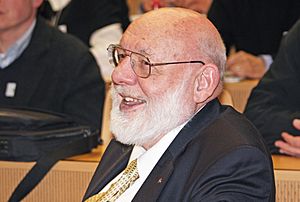Walter Jakob Gehring facts for kids
Quick facts for kids
Walter Jakob Gehring
|
|
|---|---|

Walter Jakob Gehring (2014)
|
|
| Born | 20 March 1939 Zürich, Switzerland
|
| Died | 29 May 2014 (aged 75) Basel, Switzerland
|
| Nationality | Swiss |
| Awards | Louis-Jeantet Prize for Medicine (1987) |
| Scientific career | |
| Fields | Developmental Biologist |
| Institutions | University of Zurich, Yale Medical School, Yale University, Biozentrum University of Basel |
Walter Jakob Gehring (born March 20, 1939 – died May 29, 2014) was a very important Swiss scientist. He was a developmental biologist. This means he studied how living things grow and develop from a single cell into a complete organism. He was a professor at the Biozentrum Basel at the University of Basel in Switzerland.
Walter Gehring earned his PhD from the University of Zurich in 1965. After working as a research assistant, he moved to Yale University in the United States. In 1969, he became a professor at Yale Medical School. In 1972, he returned to Switzerland. He became a professor of developmental biology and genetics at the Biozentrum of the University of Basel.
He also held important leadership roles. He was the Secretary General of the European Molecular Biology Organization. He was also the President of the International Society of Developmental Biologists. Many national science academies in countries like the USA, Great Britain, France, Germany, and Sweden made him a member.
Contents
Studying Fruit Flies
Walter Gehring spent most of his career studying Drosophila, which are tiny fruit flies. He used them to understand how animals develop. He looked at how cells decide what they will become in an embryo. He also studied how cells can change their identity later on.
He researched special genes called heat shock genes. These genes help cells survive when they are stressed by heat. He also studied transposons, which are pieces of DNA that can move around in a cell's genome.
Discovering the Homeobox
One of Gehring's most famous discoveries was the homeobox. This happened in 1983 with his team of scientists. The homeobox is a special part of DNA. It is found in genes called homeotic genes. These genes are like master switches. They control how the body parts of an animal form during development.
What was amazing is that the homeobox is not just in insects like fruit flies. It is also found in vertebrates, including humans! This discovery showed that many different animals use similar genetic tools to build their bodies.
Controlling Eye Development
Gehring and his team also worked on how eyes develop. They found a gene called PAX6. This gene acts like a master control switch for eye development. It helps to start the process of building an eye.
This discovery led to a new idea about how eyes evolved. Scientists now believe that all eyes, from simple insect eyes to complex human eyes, might have come from a single original type of eye. This idea is called the monophyletic origin of eyes.
Awards and Recognition
Walter Gehring received many important awards for his groundbreaking work. These awards recognized his huge contributions to science.
- 1987 Gairdner Foundation International Award
- 1987 Louis-Jeantet Prize for Medicine
- 1996 Awarded the Otto Warburg Medal
- 1997 Awarded the March of Dimes Prize in Developmental Biology
- 2000 Received the Kyoto Prize for Basic Science
- 2001 Alfred Vogt-Preis
- 2002 Received the Balzan Prize for Developmental Biology
- 2003 A.O. Kovalevsky Medal
See also
 In Spanish: Walter Jakob Gehring para niños
In Spanish: Walter Jakob Gehring para niños

